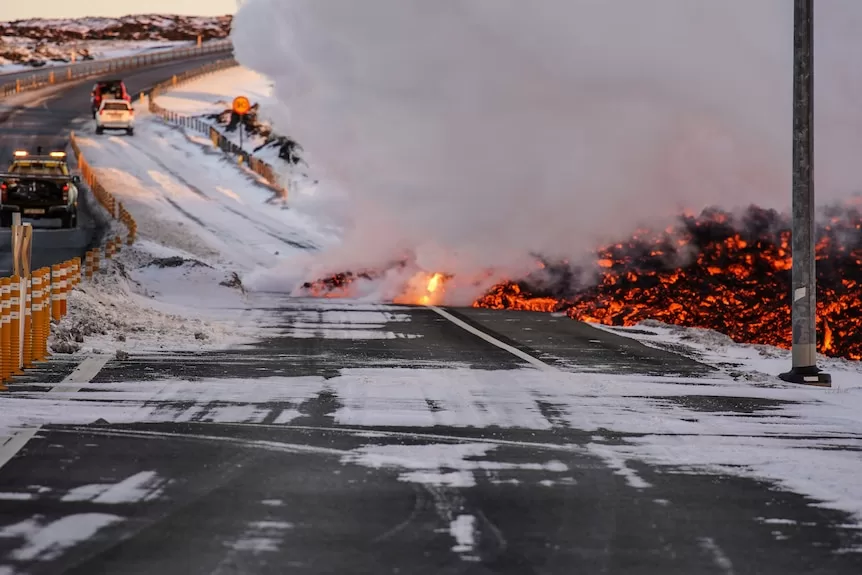- In short: A volcano in south-western Iceland has erupted for the third time since December, pumping lava up to 80 metres into the air and disrupting life in the Reykjanes peninsula.
- Intense earthquake activity began around 5:30am local time on Thursday (4:30 pm AEDT) and the eruption itself started 30 minutes later.
- What’s next? The volcanic system’s threat level has been downgraded but authorities have warned of further eruptions as land continues to rise in the area due to magma accumulating underground.
A volcano in south-western Iceland has erupted for the third time since December, pumping lava up to 80 metres into the air and disrupting life in the Reykjanes peninsula.
Fountains of bright-orange molten rock spewed from cracks in the ground and lava crossed a road near the Blue Lagoon — a luxury geothermal spa — which had closed its doors on Thursday due to the outbreak.
The lava flow also hit thermal-based water pipes in the region just south of the capital, disrupting the supply of hot water to more than 20,000 people and leading the Civil Protection Agency to raise its alert level to emergency status.
The agency also asked households and businesses to conserve electricity.
It said restoring hot water via an emergency pipeline that was already under construction could take days.
Volcanic outbreaks in the Reykjanes peninsula are so-called fissure eruptions, which do not usually cause large explosions or significant dispersal of ash into the stratosphere.
However, scientists fear they could continue for years, and Icelandic authorities have started building dykes, which are embankments, to divert burning lava flows away from homes and critical infrastructure.
Rikke Pedersen, who heads the Nordic Volcanological Centre research group based in Reykjavik, said the lava stream was about 1 km from the peninsula’s Svartsengi geothermal power plant.
Protective dykes have been built in the area and workers were trying to fill in small gaps along the road as the lava flowed.
“So they are really doing all they can to prevent lava reaching the power plant,” Ms Pedersen said.
The Iceland’s meteorological office said the “probability of new eruptive fissure openings has decreased” because the deformation in the dyke area has reduced significantly.
History of eruptions
The latest eruptive fissure, the sixth outbreak since 2021, was roughly 3 km long, according to the meteorological office said.
Intense earthquake activity began around 5:30am local time on Thursday (4:30 pm AEDT) and the eruption itself started 30 minutes later.
A plume of smoke rose 3 km into the air, according to the meteorological office.
Still, Reykjavik’s international airport, around 20 km to the north west of the fissure, was operating as normal, airport operator Isavia said.
The previous eruption in the area started on January 14 and lasted roughly two days, with lava flows reaching the outskirts of the Grindavik fishing town, whose nearly 4,000 inhabitants had been evacuated, where some houses were set alight.
Icelandic geophysicist Ari Trausti Gudmundsson said Thursday’s eruption took place some way from Grindavik and was unlikely to pose a direct threat to the town.
The meteorological office said tephra — a material as sharp as glass which forms when splashes of lava quickly cool in the air — fell in Grindavik and warned it should be carefully handled but said in the current event “the majority of tephra is deposited close to the vent and thus is not well detectable outside of the lava flow field.”
Iceland’s President Gudni Johannesson posted an image of flames and smoke in the distance on social media, saying that was the view from his residence.
“As before, our thoughts are with the people of Grindavik who cannot reside in their beautiful town. This too shall pass,” Mr Johannesson wrote.
Despite downgrading the volcanic system’s threat level, authorities have warned of further eruptions as land continued to rise in the area due to magma accumulating underground.
Mr Gudmundsson said the Reykjanes peninsula alone had six active volcanic systems and could see eruptions on-and-off for decades or potentially even centuries.
Other parts of the country have more powerful volcanoes.
In 2010, ash clouds from eruptions at Eyjafjallajökull in the south of Iceland spread over large parts of Europe, grounding some 100,000 flights and forcing hundreds of Icelanders to evacuate homes.
But unlike Eyjafjallajökull, the Reykjanes volcano systems are not trapped under glaciers and are thus not expected to cause similar-sized ash clouds.
Iceland, which is slightly larger than Tasmania, boasts more than 30 active volcanoes, making the north European island a prime destination for volcano tourism — a niche segment that attracts thousands of thrill seekers.
Reuters/ABC
